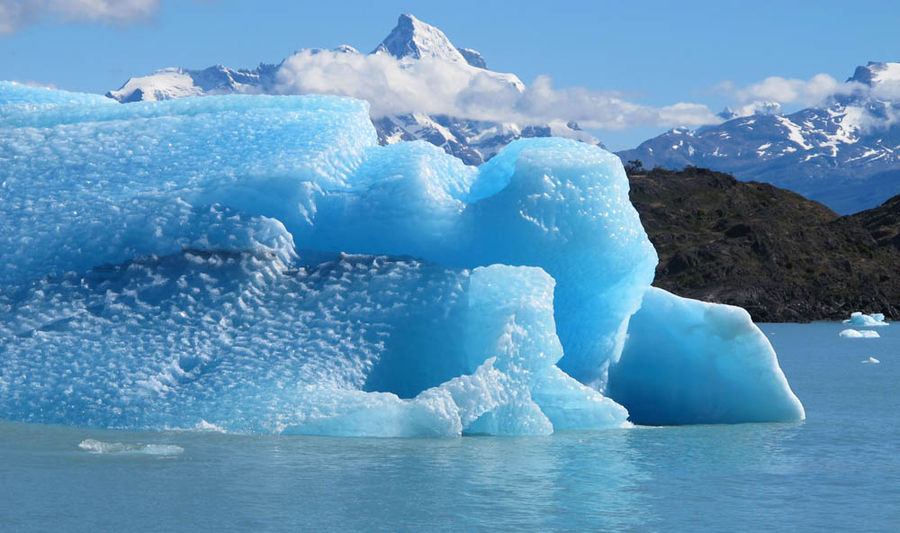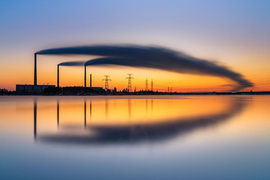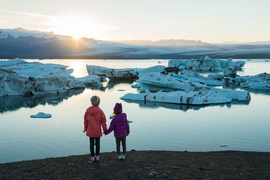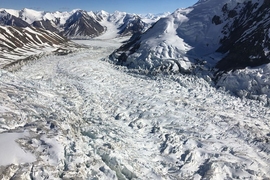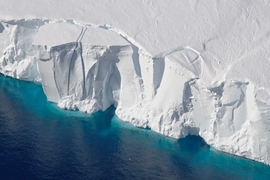When we think of climate change, one of the most dramatic images that comes to mind is the loss of glacial ice. As the Earth warms, these enormous rivers of ice become a casualty of the rising temperatures. But, as ice sheets retreat, they also become an important contributor to one the more dangerous outcomes of climate change: sea-level rise. At MIT, an interdisciplinary team of scientists is determined to improve sea level rise predictions for the next century, in part by taking a closer look at the physics of ice sheets.
Last month, two research proposals on the topic, led by Brent Minchew, the Cecil and Ida Green Career Development Professor in the Department of Earth, Atmospheric and Planetary Sciences (EAPS), were announced as finalists in the MIT Climate Grand Challenges initiative. Launched in July 2020, Climate Grand Challenges fielded almost 100 project proposals from collaborators across the Institute who heeded the bold charge: to develop research and innovations that will deliver game-changing advances in the world’s efforts to address the climate challenge.
As finalists, Minchew and his collaborators from the departments of Urban Studies and Planning, Economics, Civil and Environmental Engineering, the Haystack Observatory, and external partners, received $100,000 to develop their research plans. A subset of the 27 proposals tapped as finalists will be announced next month, making up a portfolio of multiyear "flagship" projects receiving additional funding and support.
One goal of both Minchew proposals is to more fully understand the most fundamental processes that govern rapid changes in glacial ice, and to use that understanding to build next-generation models that are more predictive of ice sheet behavior as they respond to, and influence, climate change.
“We need to develop more accurate and computationally efficient models that provide testable projections of sea-level rise over the coming decades. To do so quickly, we want to make better and more frequent observations and learn the physics of ice sheets from these data,” says Minchew. “For example, how much stress do you have to apply to ice before it breaks?”
Currently, Minchew’s Glacier Dynamics and Remote Sensing group uses satellites to observe the ice sheets on Greenland and Antarctica primarily with interferometric synthetic aperture radar (InSAR). But the data are often collected over long intervals of time, which only gives them "before and after" snapshots of big events. By taking more frequent measurements on shorter time scales, such as hours or days, they can get a more detailed picture of what is happening in the ice.
“Many of the key unknowns in our projections of what ice sheets are going to look like in the future, and how they're going to evolve, involve the dynamics of glaciers, or our understanding of how the flow speed and the resistances to flow are related,” says Minchew.
At the heart of the two proposals is the creation of SACOS, the Stratospheric Airborne Climate Observatory System. The group envisions developing solar-powered drones that can fly in the stratosphere for months at a time, taking more frequent measurements using a new lightweight, low-power radar and other high-resolution instrumentation. They also propose air-dropping sensors directly onto the ice, equipped with seismometers and GPS trackers to measure high-frequency vibrations in the ice and pinpoint the motions of its flow.
How glaciers contribute to sea level rise
Current climate models predict an increase in sea levels over the next century, but by just how much is still unclear. Estimates are anywhere from 20 centimeters to two meters, which is a large difference when it comes to enacting policy or mitigation. Minchew points out that response measures will be different, depending on which end of the scale it falls toward. If it’s closer to 20 centimeters, coastal barriers can be built to protect low-level areas. But with higher surges, such measures become too expensive and inefficient to be viable, as entire portions of cities and millions of people would have to be relocated.
“If we're looking at a future where we could get more than a meter of sea level rise by the end of the century, then we need to know about that sooner rather than later so that we can start to plan and to do our best to prepare for that scenario,” he says.
There are two ways glaciers and ice sheets contribute to rising sea levels: direct melting of the ice and accelerated transport of ice to the oceans. In Antarctica, warming waters melt the margins of the ice sheets, which tends to reduce the resistive stresses and allow ice to flow more quickly to the ocean. This thinning can also cause the ice shelves to be more prone to fracture, facilitating the calving of icebergs — events which sometimes cause even further acceleration of ice flow.
Using data collected by SACOS, Minchew and his group can better understand what material properties in the ice allow for fracturing and calving of icebergs, and build a more complete picture of how ice sheets respond to climate forces.
“What I want is to reduce and quantify the uncertainties in projections of sea level rise out to the year 2100," he says.
From that more complete picture, the team — which also includes economists, engineers, and urban planning specialists — can work on developing predictive models and methods to help communities and governments estimate the costs associated with sea level rise, develop sound infrastructure strategies, and spur engineering innovation.
Understanding glacier dynamics
More frequent radar measurements and the collection of higher-resolution seismic and GPS data will allow Minchew and the team to develop a better understanding of the broad category of glacier dynamics — including calving, an important process in setting the rate of sea level rise which is currently not well understood.
“Some of what we're doing is quite similar to what seismologists do,” he says. “They measure seismic waves following an earthquake, or a volcanic eruption, or things of this nature and use those observations to better understand the mechanisms that govern these phenomena.”
Air-droppable sensors will help them collect information about ice sheet movement, but this method comes with drawbacks — like installation and maintenance, which is difficult to do out on a massive ice sheet that is moving and melting. Also, the instruments can each only take measurements at a single location. Minchew equates it to a bobber in water: All it can tell you is how the bobber moves as the waves disturb it.
But by also taking continuous radar measurements from the air, Minchew’s team can collect observations both in space and in time. Instead of just watching the bobber in the water, they can effectively make a movie of the waves propagating out, as well as visualize processes like iceberg calving happening in multiple dimensions.
Once the bobbers are in place and the movies recorded, the next step is developing machine learning algorithms to help analyze all the new data being collected. While this data-driven kind of discovery has been a hot topic in other fields, this is the first time it has been applied to glacier research.
“We've developed this new methodology to ingest this huge amount of data,” he says, “and from that create an entirely new way of analyzing the system to answer these fundamental and critically important questions.”
